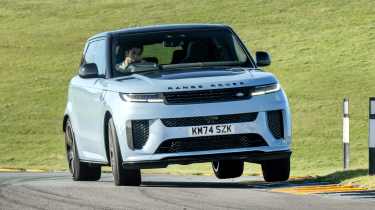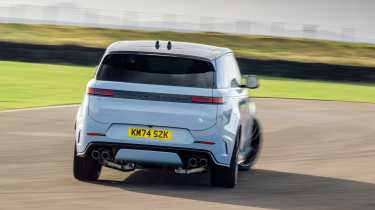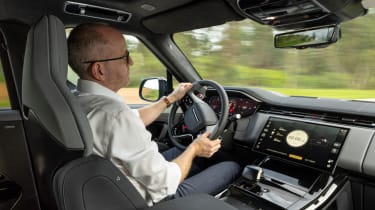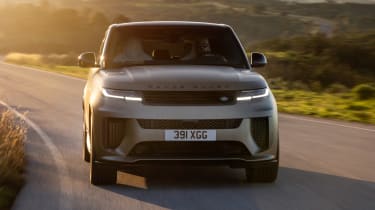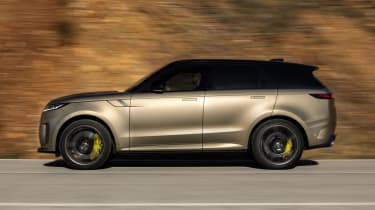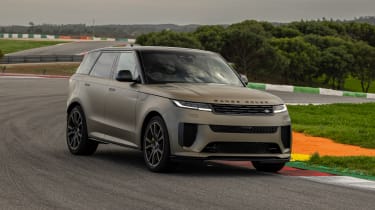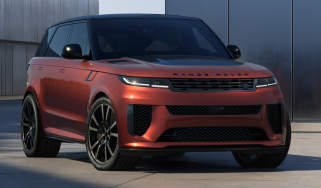Range Rover Sport SV 2025 review – the king of fast SUVs?
The SV packs the kind of chassis tech you'd expect to find in a McLaren rather than a Range Rover. The result is a quite extraordinary performance SUV
Remember the old Range Rover Sport SVR? Painted bright blue, a pair of Recaro seats that wouldn’t look out of place in a Project 8 and an exhaust system that came out of the factory set to obnoxious mode? Its replacement is nothing like that, and that’s a very good thing. What you’re looking at is one of the most accomplished fast SUVs of all – which it needs to be, because despite what you thought of the old SVR, in terms of positive financial performance no model in the Land Rover line up got close to it.
The latest Range Rover Sport feels more like a smaller Range Rover rather than an SUV with genuine sporting pretensions, even in P530 V8 guise. Its refinement, comfort and material quality are far closer to luxury than anything sporting. The SV, meanwhile, aims to address that with chassis tech you'd normally expect to find under a cutting-edge sports car.
Land Rover has thrown everything at the SV to create a credible competitor to the likes of the Porsche Cayenne Turbo E-Hybrid and Aston Martin DBX707 – SUVs that are enjoyable and dynamic to drive despite every element of physics working against them. It’s essentially a front-engined, rear-drive car, with an e-diff at the rear and a centre diff that JLR also describes as an e-diff (it’s a multi-plate clutch) sending drive to the (open) front diff via a shorter propshaft. Up to 50 per cent of drive can go to the front axle and the mode selected sets the level of rear-drive bias, from around 70 per cent in Comfort, up to 80 per cent in SV mode, though with no drive to the front when cruising.
More reviews
The clever stuff on the Sport SV – and the Land Rover Defender Octa – to take the dynamics to another level is JLR’s bespoke ‘6D’ system. Indeed, 6D seems to be the current buzzword in the motor industry and it describes a vehicle’s movements – lateral, longitudinal and vertical, plus pitch, roll and yaw. A 6D controller monitors and, if you have enough ‘levers’ to pull, helps manage the vehicle’s behaviour. The Sport SV has plenty of levers, notably hydraulically interlinked dampers and height adjustable air springs, which are very useful both off-road and on.
In terms of fast driving, the key things that JLR has been able to manage are pitch and roll, helping contain and control the substantial weight of the SV so it doesn’t dictate its dynamic behaviour. In addition, the lightweight carbon brakes and carbon wheels enhance control and also mean that you can use all the SV’s performance without worrying about fade.
Can such hardware really turn a 2.5-ton SUV into something resembling a car you can interact with and not regret choosing if you find yourself on a road with more corners than a UK high street has branches of Costa coffee? Land Rover must think so, because they let us loose in the SV on track to fully explore what it can do – and the results were quite remarkable.
In SV mode there’s a directness and linearity in how the steering reacts to inputs, allowing for a clean arc to be scribed through varying angles of corner the track offers. The weight and response rate feel natural and instinctive, its willingness to allow corrections without shocking the systems are unexpected from a car in this sector.
Much of how cleanly the SV steers is down to the 6D dynamics. Although there’s still a degree of roll that allows you to lean against, the system prevents the excessive lurching such cars struggle to control under hard cornering and braking - JLR says it can generate 1.1g of lateral load on the standard all-season tyre, and 1.2g on the optional Michelin Pilot S 5 rubber. Throw in the bespoke rear-wheel steering and the SV feels totally within itself on track. Flowing from turn-in to apex to corner exit with such confidence, you almost feel guilty for being so impressed by the capability of a car you’d expect to see parked in the paddock and not clipping an apex.
A torque limit for the eight-speed ZF automatic prevents the BMW 4.4-litre twin-turbocharged V8 from offering the on-throttle adjustability the likes of Aston Martin’s DBX707 and Ferrari Purosangue offer, but this is an SUV that can also tackle the kind of off-road terrain you’d expect a Range Rover to deal with, and on-the-limit throttle adjustability is, most likely, very low down the priority list of owners.
Dynamically the SV has been set up and optimised for running on the standard Michelin Pilot 4 S tyres and forged wheels, rather than the optional 23-inch carbonfibre wheels and S 5 rubber fitted to our test car. On the track they find remarkable purchase, communicating any slip back to your fingers as cleanly as they can, allowing you to build confidence and tuck into the V8’s grunt. If you do find yourself at the Nürburgring with your SV, the 5 S tyre will now last eight laps before shredding itself to oblivion, where the previous SVR would destroy a set of tyres within two.
Sourced from BMW, the hot-vee V8 delivers 625bhp and 590lb ft of torque, and for what it lacks in drama compared to the old 5-litre supercharged V8, it makes up for with a more cultured and subtle tone. Your neighbours will approve, owners of BO55 number plates less so. Protecting the gearbox from a torque overload makes the downshifts slower than you’d ideally want when enjoying all that performance, and can result in a second pull of the left hand paddle just when you think the gear you asked for wasn’t going to arrive. Performance is on another plane to the old SVR, with 62mph arriving in 3.8 seconds (or two-tenths quicker if you go for the carbon wheels and sticker tyres).
Carbon ceramic brake discs, the first fitted to a Range Rover and developed by Brembo, are an option and measure 440mm at the front, 390mm at the rear and their eight-piston calipers feature an X-pattern design to maximise braking performance. A handful of track laps didn’t find them wilting, and unlike many carbon ceramic setups the pedal feel isn’t masked with dead-spots in the travel, which is all the better for modulation.
On the road, where the Sport SV will spend all its time in reality, it's a far less boisterous machine than its predecessor. In Comfort mode it feels noticeably more locked down than the Sport P530 that shares the same engine and adds a level of tautness to the body control as the 6D software works to prevent unnecessary pitch and roll, or ‘nodding head’ syndrome as one engineer described it.
Fitting 23-inch carbon wheels and carbon ceramics saves over 70kg in unsprung mass, and on poor surfaces where your eyes tell you to prepare for a shake and shudder over the upcoming terrain, the SV is far more composed than your expectations. A regular Sport would struggle to absorb the impacts, while Aston’s DBX and Ferrari’s Purosangue would certainly let you know exactly what the wheels and tyres are dealing with.
And just as the SV impresses on track with its willingness to turn in, mid-corner balance and accelerative energy, the same is true on the road. If anything it’s more impressive because, cliche alert, the way it shrinks itself around you makes for an easier than expected ability to place the car exactly where you need. Any vagueness and imprecision dismissed. It’s no M5 CS, but it jumps to the top of the pile in its class in how it conducts itself when asked to deliver on its credentials.
On the standard steel brakes and 23-inch forged wheels, the SV is still reassuringly composed but loses just a little of its dynamic shine. The heavier wheels and brakes tend to bounce around in the wheelarches without the buttoned-down control of their carbon counterparts through rougher sections.
That manifests in the Range Rover Sport SV’s veil of absolute dynamic containment being pierced intermittently with the odd bounce and shudder, such that the extra £13,900 for both the lighter wheels and brakes might just be worth it. The steel discs lose 20mm of size at the front to the 440mm carbons, too.
Is the added strength of the ceramic brakes missed on the road? Not really. You’d need a week of abuse on an eCoty test to find the limits of the highly capable steel stoppers on the road. But the carbon items really are impressive. After the launch at Portimao, Range Rover revealed that carbon brake-equipped test cars had 30 per cent of usable life left in their brake pads after 215 laps, which equates to 615 track miles. So if you plan to put many hard miles on your Sport SV, the carbons could actually prove cheaper than the quicker-wearing steels in the long run.
It’s still worth looking beyond the occasionally pogo-prone de-carbonised wheels and brakes to observe the genius of the 6D Dynamics suspension. Even on British roads the breadth of its capability is spectacular, with the Sport SV’s sinews able to tighten at the click of that SV button. No, the hardest mode isn’t ideal on the roughest, most topographically demanding sections of our road network but on a reasonable stretch that allows pace, it really comes into its own.
Perhaps a bit more weight build-up in the quickened steering rack in low-speed corners wouldn’t go amiss, to tie it all together. Nevertheless, this remains a Range Rover quite unlike any other and for the first time, is a genuine player in terms of dynamics, if not absolute interaction, next to the very best Porsche Cayennes and even the Aston Martin DBX707.
On the flip side, the suspension can be slackened off to the point of adding an extra layer of sophistication to the kind of road manners you’d ordinarily expect of a Range Rover. Being the SV, that last five per cent of refinement is perhaps missing compared to a normal Range Rover, but it’s certainly less jarring than the SVR it replaces. Needless to say, it’ll also put in a shift on the rough stuff that rivals from Porsche, Aston Martin, and beyond likely couldn’t hope to replicate.
There is, of course, no need for a 635bhp, 2.5-ton SUV that’s as competent on track and the road as the SV is. But you can say that about so many cars, and the SV showcases technology that really does transform the driving experience for the better. Making such big cars more precise, and therefore easier to control and manage, has to be a good thing. And the Range Rover Sport SV is a very good thing indeed.
Price and rivals
Though the initial run of Edition 1 cars is spoken for, Range Rover has since announced the Sport SV Edition 2, which is available to order now with a selection of new options. Prices start from £174,545 and yes, that’s before the carbon wheels (£6900) and brakes (£7000) are added.
Against the £166,100, GT Package-equipped Porsche Cayenne Turbo E-Hybrid coupe that’s quite the jump, although Aston Martin’s new DBX S starts at £210,000 – it remains to be seen whether it retains the dynamic advantage the 707 enjoyed.
